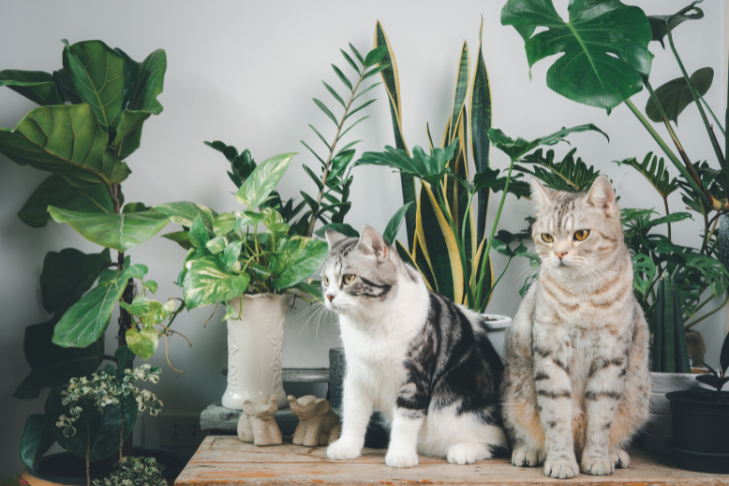A Pet Parents Guide to Toxic-Free Plants & Indoor Gardening

The charm of indoor gardening is irresistible—it not only enhances home aesthetics and transforms living spaces into green sanctuaries but also improves air quality and reduces stress. However, for those of us who share our homes with pets, their safety takes center stage when bringing nature indoors. Follow this guide to cultivate a thriving indoor garden that keeps your pets safe, happy, and healthy.
Health Benefits of Indoor Gardens
Having plants, flowers, or an indoor garden isn’t just about enhancing the look of your space; they can also boost your health. Plants act as natural air purifiers, absorbing toxins and releasing fresh oxygen, making it easier to breathe at home. Plants act as natural air purifiers, absorbing toxins and releasing fresh oxygen, making it easier to breathe at homes. They’re known to increase humidity, providing relief for your skin, especially during drier weather. Beyond the physical benefits, being around plants can help lower stress levels, transforming your home into a calm and safe space. Indoor gardens can also improve your mood and enhance concentration and productivity when you’re working or studying, thereby boosting your overall well-being.
Selecting Pet-Friendly Plants
Thinking about adding more green to your space or traveling and staying in a new place that has plants? The key to a pet-friendly indoor garden is picking plants that pose no risk to your pets. The botanical world is huge, but not all plants are pet-friendly. In fact, some of the most popular plants can be super dangerous to pets if ingested. To create a safe and vibrant indoor garden, here are some non-toxic options to choose from:
- African Violet (Saintpaulia): Brighten your space with these colorful blooms that are safe for pets and thrive in indirect sunlight.
- Bamboo Palm (Chamaedorea seifrizii): A pet-safe choice that also serves as a natural air purifier.
- Money Tree (Pachira aquatica): Known for its braided trunk and lush leaves, the money tree is not only pet-friendly but also known to bring good fortune!
- Cast Iron Plant (Aspidistra elatior): Named for its resilience, this plant is ideal for low-light conditions and is completely safe for pets.
Plants Pet Parents Should Avoid
When pets chew on or ingest plant leaves, stems, flowers, or even roots, they can be exposed to natural chemical compounds that are harmful to them. Toxic plants pose varying degrees of risk to pets, primarily through ingestion. The term “toxic” encompasses a broad spectrum of potential effects, from mild irritations that may cause discomfort to more serious conditions. The severity of the reaction depends on the specific plant involved, the amount consumed, and the individual pet’s sensitivity or allergic reactions to the plant’s toxic components.
It’s also worth noting that the same plant can have different levels of toxicity depending on its part. Additionally, the age of the plant and the season can also affect toxicity levels. Understanding the specific risks associated with certain plants can help pet parents take the necessary precautions to prevent accidental ingestion from occurring.

Here’s a list of some common plants that are toxic to pets:
- Snake plants: Can cause nausea, vomiting, and diarrhea if ingested, due to their saponin content.
- Pothos: The insoluble calcium oxalates in pothos can lead to oral irritation, intense burning and irritation of the mouth, tongue, and lips, excessive drooling, vomiting, and difficulty swallowing.
- Lilies: Extremely toxic to cats, even in small amounts. Ingesting even a petal or two can lead to severe kidney damage. Not all lily species are as dangerous to dogs, but it’s best to keep these away from all pets.
- Rubber plants: Contain a milky white sap that can irritate pets’ skin and, if ingested, can cause mouth and stomach irritation leading to vomiting.
- ZZ plants: Contain calcium oxalate crystals similar to pothos, leading to oral irritation, vomiting, and diarrhea.
- Chrysanthemums: Contain compounds that can cause vomiting, diarrhea, hypersalivation, incoordination, and dermatitis in pets.
- Azaleas: Ingesting even a few leaves can result in oral irritation, vomiting, diarrhea, weakness, and central nervous system decline in pets.
- Tulips: The bulb contains toxins that can cause intense gastrointestinal irritation, drooling, loss of appetite, decline of the central nervous system, convulsions, and even cardiac abnormalities.
Tips for Pet-Safe Indoor Gardening
When setting up a pet-safe indoor garden, it’s about more than just picking the right plants. Here are some tips to make sure that your plants thrive without endangering your pets:
- Strategic Plant Placement: Keep plants out of paw’s reach by using tall plant stands, shelves, or hanging planters. This not only protects your plants but also prevents pets from nibbling on them.
- Natural Pest Solutions: When choosing pest control, opt for pet-friendly alternatives to chemical pesticides. Rodenticides, for example, can be very dangerous if ingested and can lead to life-threatening issues if not treated properly. Symptoms can range from neurological signs to kidney damage or internal bleeding. Solutions like insecticidal soap or introducing beneficial insects can be effective without harming your pets.
- Mindful Watering Practices: Overwatering can lead to harmful mold growth. Check for proper drainage and monitor soil moisture to keep both your plants and pets healthy.
- Pet-Specific Plant Zones: If you can, designate a specific area for your indoor garden that isn’t accessible to your pets. This could be a room with a door or an area blocked off by pet gates.
By opting for non-toxic plants and following these guidelines for pet-safe indoor gardening, you’re creating a vibrant and dynamic living space that benefits everyone who shares it. This approach allows you to enjoy all the perks of an indoor garden without compromising your pets’ health or safety.


